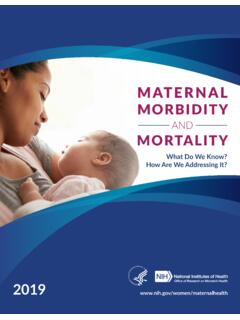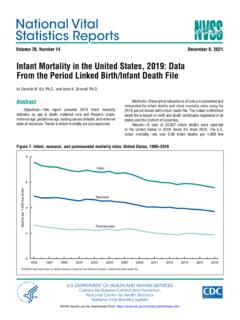Transcription of A LITERATURE REVIEW AND META-ANALYSIS OF THE …
1 Ambika Kandasamy A LITERATURE REVIEW AND META-ANALYSIS OF THE EFFECTS OF LOCKDOWNS ON COVID-19 MORTALITYRTALITY 2022/October 2021 Jonas Herby, Lars Jonung, and Steve H. Hanke 1 A LITERATURE REVIEW and META-ANALYSIS of the Effects of Lockdowns on COVID-19 mortality By Jonas Herby, Lars Jonung, and Steve H. Hanke About the Series The Studies in Applied Economics series is under the general direction of Prof. Steve H. Hanke, Founder and Co-Director of The Johns Hopkins Institute for Applied Economics, Global Health, and the Study of Business Enterprise The views expressed in each working paper are those of the authors and not necessarily those of the institutions that the authors are affiliated with. About the Authors Jonas Herby is special advisor at Center for Political Studies in Copenhagen, Denmark. His research focuses on law and economics. He holds a master s degree in economics from University of Copenhagen.
2 Lars Jonung is professor emeritus in economics at Lund University, Sweden. He served as chairperson of the Swedish Fiscal Policy Council 2012-13, as research advisor at the European Commission 2000-2010, and as chief economic adviser to Prime Minister Carl Bildt in 1992-94. He holds a PhD in Economics from the University of California, Los Angeles. Steve H. Hanke is a Professor of Applied Economics and Founder & Co-Director of The Johns Hopkins Institute for Applied Economics, Global Health, and the Study of Business Enterprise. He is a Senior Fellow and Director of the Troubled Currencies Project at the Cato Institute, a contributor at National REVIEW , a well-known currency reformer, and a currency and commodity trader. Prof. Hanke served on President Reagan s Council of Economic Advisers, has been an adviser to five foreign heads of state and five foreign cabinet ministers, and held a cabinet-level rank in both Lithuania and Montenegro.
3 He has been awarded seven honorary doctorate degrees and is an Honorary Professor at four foreign institutions. He was President of Toronto Trust Argentina in Buenos Aires in 1995, when it was the world s best-performing mutual fund. Currently, he serves as Chairman of the Supervisory Board of Advanced Metallurgical Group in Amsterdam. In 1998, he was named one of the twenty- five most influential people in the world by World Trade Magazine. In 2020, Prof. Hanke was named a Knight of the Order of the Flag. 2 Abstract This systematic REVIEW and META-ANALYSIS are designed to determine whether there is empirical evidence to support the belief that lockdowns reduce COVID-19 mortality . Lockdowns are defined as the imposition of at least one compulsory, non-pharmaceutical intervention (NPI). NPIs are any government mandate that directly restrict peoples possibilities, such as policies that limit internal movement, close schools and businesses, and ban international travel.
4 This study employed a systematic search and screening procedure in which 18,590 studies are identified that could potentially address the belief posed. After three levels of screening, 34 studies ultimately qualified. Of those 34 eligible studies, 24 qualified for inclusion in the META-ANALYSIS . They were separated into three groups: lockdown stringency index studies, shelter-in-place-order (SIPO) studies, and specific NPI studies. An analysis of each of these three groups support the conclusion that lockdowns have had little to no effect on COVID-19 mortality . More specifically, stringency index studies find that lockdowns in Europe and the United States only reduced COVID-19 mortality by on average. SIPOs were also ineffective, only reducing COVID-19 mortality by on average. Specific NPI studies also find no broad-based evidence of noticeable effects on COVID-19 mortality .
5 While this META-ANALYSIS concludes that lockdowns have had little to no public health effects, they have imposed enormous economic and social costs where they have been adopted. In consequence, lockdown policies are ill-founded and should be rejected as a pandemic policy instrument. Acknowledgements The authors thank Line Andersen, Troels Sabroe Ebbesen, Nicholas Hanlon, and Anders Lund Mortensen for their research assistance. The authors also with to thank Douglas Allen, Fredrik N. G. Andersson, Jonas Bj rk, Christian Bj rnskov, Joakim Book, Gunnar Br dvik, Kristoffer Torbj rn B k, Ulf Gerdtham, Daniel B. Klein, Fredrik Charpentier Ljungqvist, Christian Heeb l-Nielsen, Martin Paldam, Jonas Ranstam, Spencer Ryan, John Strezewski, Roger Svensson, Ulf Persson, Anders Waldenstr m, and Joakim Westerlund for their comments. Key Words: COVID-19, lockdown, non-pharmaceutical interventions, mortality , systematic REVIEW , META-ANALYSIS JEL Classification: I18; I38; D19 3 1 Introduction The global policy reaction to the COVID-19 pandemic is evident.
6 Compulsory non-pharmaceutical interventions (NPIs), commonly known as lockdowns policies that restrict internal movement, close schools and businesses, and ban international travel have been mandated in one form or another in almost every country. The first NPIs were implemented in China. From there, the pandemic and NPIs spread first to Italy and later to virtually all other countries, see Figure 1. Of the 186 countries covered by the Oxford COVID-19 Government Response Tracker (OxCGRT), only Comoros, an island country in the Indian Ocean, did not impose at least one NPI before the end of March 2020. Figure 1: Share of countries with OxCGRT stringency index above thresholds, January - June 2020 Comment: The figure shows the share of countries, where the OxCGRT stringency index on a given date surpassed index 65, 70 and 75 respectively. Only countries with more than one million citizens are included (153 countries in total).
7 The OxCGRT stringency index records the strictness of NPI policies that restrict people s behavior. It is calculated using all ordinal containment and closure policy indicators ( , the degree of school and business closures, etc.), plus an indicator recording public information campaigns. Source: Our World in Data. Early epidemiological studies predicted large effects of NPIs. An often cited model simulation study by researchers at the Imperial College London (Ferguson et al. (2020)) predicted that a 4 suppression strategy based on a lockdown would reduce COVID-19 mortality by up to 98%.1 These predictions were questioned by many scholars. Our early interest in the subject was spurred by two studies. First, Atkeson et al. (2020) showed that across all countries and states that we study, the growth rates of daily deaths from COVID-19 fell from a wide range of initially high levels to levels close to zero within 20-30 days after each region experienced 25 cumulative deaths.
8 Second, Sebhatu et al. (2020) showed that government policies are strongly driven by the policies initiated in other countries, and less by the specific COVID-19-situation of the country. A third factor that motivated our research was the fact that there was no clear negative correlation between the degree of lockdown and fatalities in the spring of 2020 (see Figure 2). Given the large effects predicted by simulation studies such as Ferguson et al. (2020), we would have expected to at least observe a simple negative correlation between COVID-19 mortality and the degree to which lockdowns were Figure 2: Correlation between stringency index and COVID-19 mortality in European countries and states during the first wave in 2020 Source: Our World in Data 1 With R0 = and trigger on 60, the number of COVID-19-deaths in Great Britain could be reduced to 8,700 deaths from 510,000 deaths (-98%) with a policy consisting of case isolation + home quarantine + social distancing + school/university closure, cf.
9 Table 4 in Ferguson et al. (2020). R0 (the basic reproduction rate) is the expected number of cases directly generated by one case in a population where all individuals are susceptible to infection. 2 In addition, the interest in this issue was sparked by the work Jonung did on the expected economic effects of the SARS pandemic in Europe in 2006 (Jonung and R ger, 2006). In this model-based study calibrated from Spanish flu data, Jonung and R ger concluded that the economic effects of a severe pandemic would be rather limited a sharp contrast to the huge economic effects associated with lockdowns during the COVID-19 pandemic. 5 Today, it remains an open question as to whether lockdowns have had a large, significant effect on COVID-19 mortality . We address this question by evaluating the current academic LITERATURE on the relationship between lockdowns and COVID-19 mortality We use NPI to describe any government mandate which directly restrict peoples possibilities.
10 Our definition does not include governmental recommendations, governmental information campaigns, access to mass testing, voluntary social distancing, etc., but do include mandated interventions such as closing schools or businesses, mandated face masks etc. We define lockdown as any policy consisting of at least one NPI as described Compared to other reviews such as Herby (2021) and Allen (2021), the main difference in this META-ANALYSIS is that we carry out a systematic and comprehensive search strategy to identify all papers potentially relevant to answer the question we pose. We identify 34 eligible empirical studies that estimate the effect of mandatory lockdowns on COVID-19 mortality using a counterfactual difference-in-difference approach. We present our results in such a way that they can be systematically assessed, replicated, and used to derive overall 2 Identification process: Search strategy and eligibility criteria Figure 3 shows an overview of our identification process using a flow diagram designed according to PRISMA guidelines (Moher et al.)






